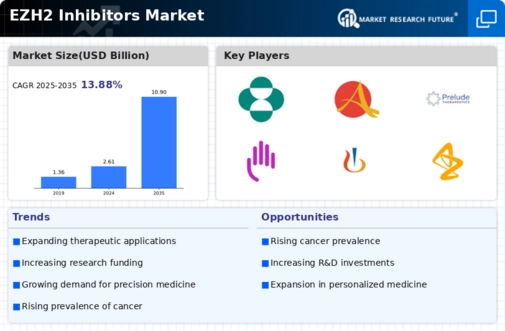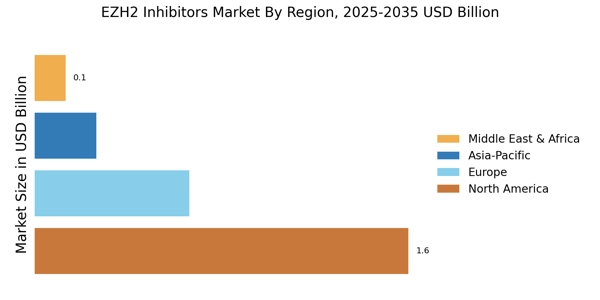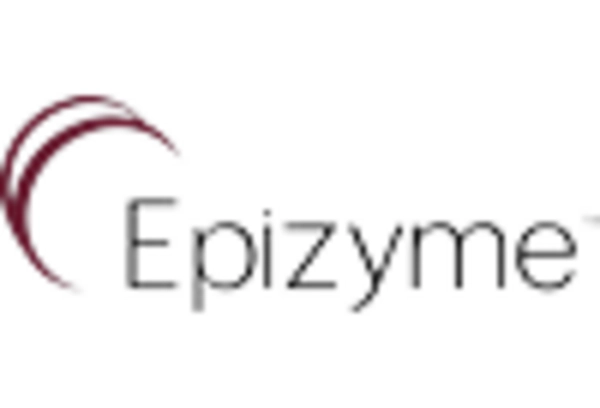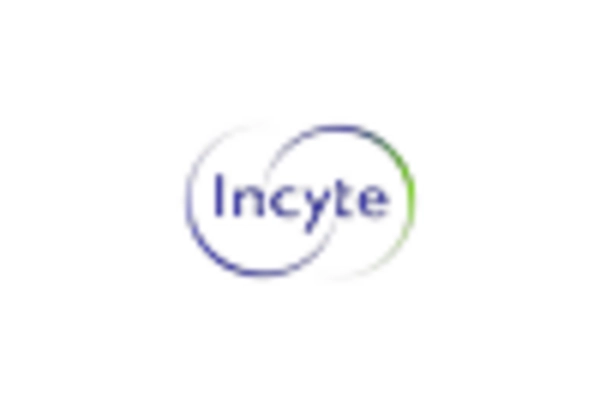Increasing Cancer Prevalence
The rising incidence of various cancers, particularly hematological malignancies, is a primary driver for the EZH2 Inhibitors Market. As cancer cases continue to escalate, the demand for innovative treatment options intensifies. EZH2 inhibitors have emerged as promising therapeutic agents, particularly in the treatment of lymphomas and other solid tumors. According to recent estimates, the prevalence of cancer is projected to reach approximately 29.5 million cases by 2040, which underscores the urgent need for effective therapies. This growing patient population is likely to propel the EZH2 inhibitors market, as healthcare providers seek advanced solutions to improve patient outcomes. Furthermore, the increasing awareness of targeted therapies among patients and healthcare professionals may further stimulate market growth, as these inhibitors offer a more personalized approach to cancer treatment.
Advancements in Drug Development
Innovations in drug development methodologies are significantly influencing the EZH2 Inhibitors Market. The advent of high-throughput screening and advanced molecular modeling techniques has accelerated the discovery and optimization of EZH2 inhibitors. These advancements enable researchers to identify potential drug candidates more efficiently, thereby reducing the time and cost associated with bringing new therapies to market. Recent data indicates that The EZH2 Inhibitors Market is expected to reach USD 200 billion by 2025, highlighting the lucrative opportunities for EZH2 inhibitors within this expanding sector. Additionally, the integration of artificial intelligence in drug discovery processes may further enhance the efficacy and specificity of EZH2 inhibitors, making them more appealing to pharmaceutical companies and investors alike.
Regulatory Approvals and Support
Regulatory approvals for EZH2 inhibitors are playing a crucial role in shaping the EZH2 Inhibitors Market. The expedited review processes and supportive regulatory frameworks established by agencies such as the FDA and EMA have accelerated the approval timelines for novel therapies. This regulatory environment encourages pharmaceutical companies to invest in the development of EZH2 inhibitors, knowing that there is a pathway for bringing their products to market more swiftly. Recent approvals of EZH2 inhibitors for specific cancer indications have not only validated their therapeutic potential but have also instilled confidence among investors and stakeholders. As more EZH2 inhibitors receive regulatory backing, the market is likely to experience increased competition and innovation, ultimately benefiting patients with limited treatment options.
Rising Demand for Targeted Therapies
The growing demand for targeted therapies is a pivotal driver for the EZH2 Inhibitors Market. Patients and healthcare providers are increasingly favoring treatments that offer specificity and reduced side effects compared to traditional chemotherapy. EZH2 inhibitors, which target specific epigenetic mechanisms involved in cancer progression, align well with this trend. Market analysis suggests that the targeted therapy segment is expected to account for over 50% of the oncology market by 2026, reflecting a shift towards more personalized treatment approaches. This demand is further fueled by the increasing availability of biomarker testing, which allows for the identification of patients who are most likely to benefit from EZH2 inhibitors. As awareness of these therapies grows, the EZH2 inhibitors market is anticipated to expand, driven by both patient preference and clinical efficacy.
Growing Investment in Oncology Research
The increasing investment in oncology research is a significant driver for the EZH2 Inhibitors Market. Pharmaceutical companies and research institutions are allocating substantial resources to explore novel cancer therapies, including EZH2 inhibitors. This trend is evidenced by the rising number of clinical trials focused on EZH2-targeted therapies, which have seen a marked increase in funding and support. In 2023, the total funding for cancer research reached approximately USD 60 billion, with a notable portion directed towards understanding the role of epigenetic modifications in cancer progression. This influx of capital not only facilitates the development of new EZH2 inhibitors but also fosters collaborations between academia and industry, further enhancing the market landscape. As research continues to unveil the potential of these inhibitors, the market is poised for robust growth.


















Leave a Comment